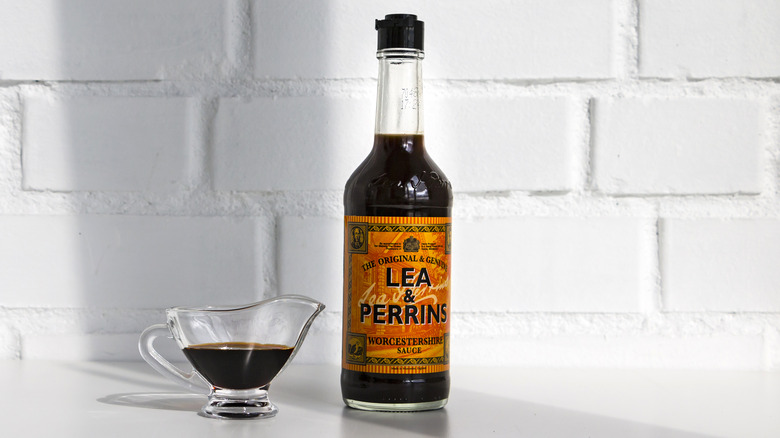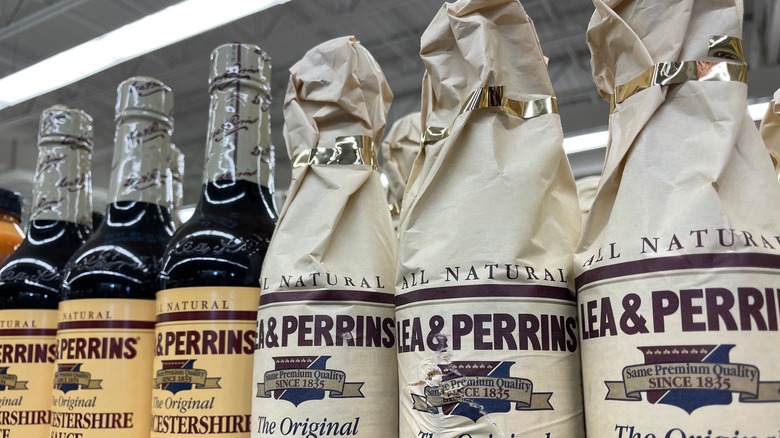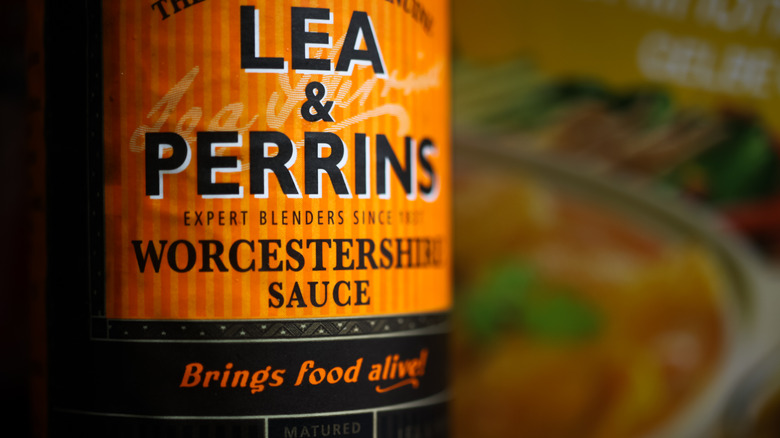The Mystery And History Of Worcestershire Sauce
Any discussion of Worcestershire sauce has to begin with its tongue-twisting name. You'll hear a lot of cooks on TikTok, YouTube, and even TV calling it "WUR-ster-sher" or "WAR-sest-ter-shire" — some out of confusion and others out of jest — but for the record, it's pronounced "WUS-ter-sher."
The moniker comes from the English county of Worcestershire and the town of Worcester, where the namesake sauce has been made for nearly 200 years. If it troubles you, you can call it "Lea & Perrins" sauce for the brand name stamped on each bottle's paper packaging. This honors the condiment's co-inventors, John Wheeley Lea and William Henry Perrins, but how these two men came up with their invention is a mystery. In fact, many things about Worcestershire sauce are.
For instance, what is the flavor of Worcestershire sauce? Some will simply say umami, as if that gives you any clear idea of what you'll experience when it hits your tongue. Then again, trying to describe the taste in specific terms merely generates a list of vague, conflicting words. It's peppery, salty, sweet, acidic, and funky in a way that defies explanation.
One reason its flavor is so enigmatic is that the recipe for Worcestershire sauce has been a closely guarded secret since its inception. In fact, even the ingredients were a mystery until a chance discovery unveiled them to the public.
What is Worcestershire sauce?
One of the main reasons Worcestershire sauce is so hard to describe is that it's hard to compare. There's a distinct hint of fish sauce in it, but that only scratches the surface of the complex flavor profile. The condiment that seems most closely related to Worcestershire is an uncommon one.
It's called garum, and it was a big hit roughly 1,700 years ago in the kitchens of the Roman Empire. Garum was made from fermented fish, mixed with an array of ingredients that included wine, honey, black pepper, and vinegar. That's pretty similar to Worcestershire sauce.
Nobody knew exactly what went into Worcestershire sauce until Brian Keogh, a former Lea & Perrins accountant, discovered a discarded pair of notebooks near the company's headquarters. According to the BBC, He held onto these notebooks until his death in 2006, after which his daughter found the notes and revealed the sauce's ingredients and recipe to the public.
They revealed that Worcestershire sauce contains 20.5 pounds of water, two pounds of cloves, 10 pounds of salt, 34 pounds of sugar, eight gallons of soy, 24 pounds of fish, 18 gallons of vinegar, two gallons of acetic acid, eight ounces of lemon oil, five pounds of peppers, 14 pounds of tamarind, and a whopping 40 pounds of pickles (variety unspecified). Just what to do with these ingredients remains unknown, but if you want to brew a couple hundred pounds of the stuff, you now know where to start.
The history of Worcestershire sauce
The details of Worcestershire sauce's origins are sparse, but according to Epicurious, the story generally goes something like this. Lea and Perrins were pharmacists in Worcester, and like most pharmacists of that time, they dealt in more matters than medicine, including food.
One day in 1835, Lord Marcus Sandys, the former governor of British–controlled Bengal approached the pair with a special request. He described a savory Indian sauce he loved, and he wanted them to recreate it. He handed over a recipe, but when they tried whipping up a batch, the result tasted awful.
Discouraged, the pharmacists abandoned the barrel of sauce for a couple of years, but upon stumbling across it again, they found that the mixture had fermented into a state of deliciousness. They brewed more batches and, thanks to an aggressive marketing campaign, Worcestershire sauce became an instant hit.
This story has many variations: Some say Sandys brought Lea and Perrins a form of curry powder that they then dissolved into their sauce. Others say the customer requested the sauce but never returned to collect it, leading it to sit unattended for so long.
However, Keogh's records reveal that Lord Sandys was never the governor of Bengal. In fact, no records indicate he ever traveled to India at all. The nobleman's tale may have been nothing more than another marketing tactic by Lea and Perrins, and the true origin of Worcestershire sauce is presumably buried with its creators.


